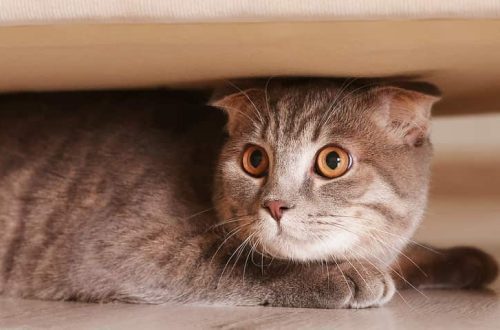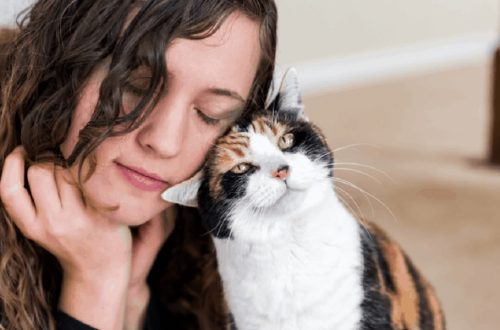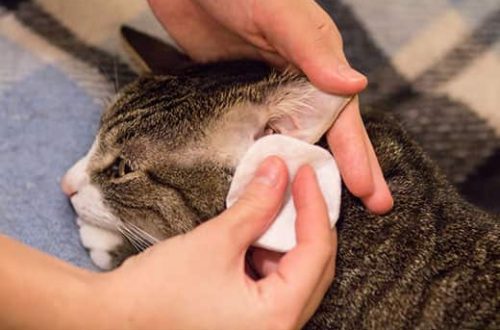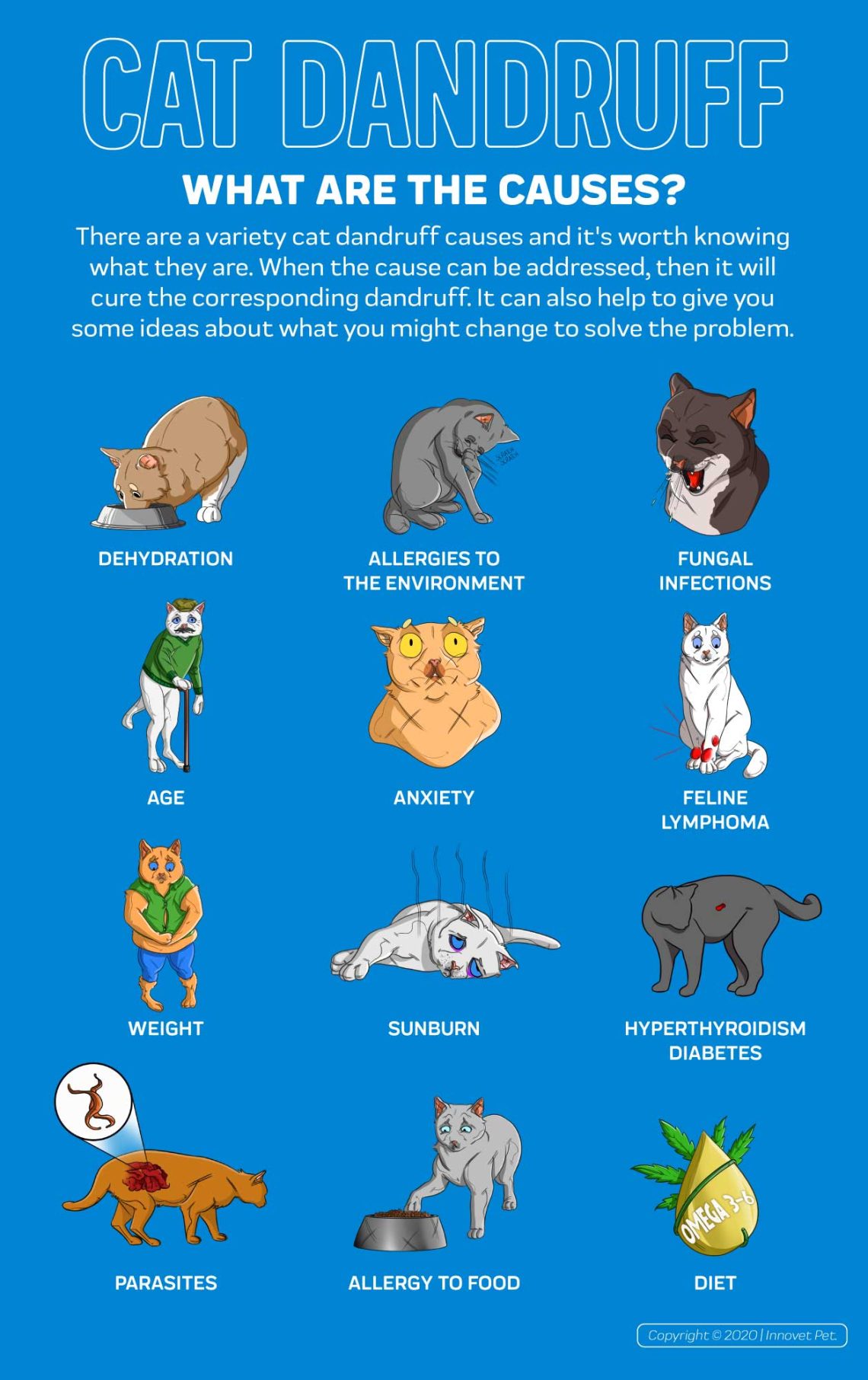
Dandruff in cats: causes, types, features of diagnosis, treatment and prevention
Contents
What kind of dandruff does cats have
There are 3 types of dandruff in felines.
- Dry. It can be shaken off the hands, wool. Gives the hairline of the animal a dry, dull look.
- Oily. May vary in density. So, the “liquid” version is manifested by a pronounced greasiness of the hairs, which are glued together. If the animal is stroked, the excess secretion will remain in the palm of your hand. With increased density of dandruff (there is less greasy secretion, and more skin flakes), it remains in large quantities under the owner’s nails when trying to scratch the pet.
- Mixed. The necrosis of skin cells and the work of the sebaceous glands occur unevenly on the surface of the animal’s body, which leads to the alternation of dry and oily seborrhea.
Why does dandruff occur in cats?
Causes that cause dandruff in cats are divided into two categories: external and internal.
- Poor grooming (poor combing, infrequent washing, unsanitary living conditions, etc.)
- Dry air (dry skin leads not only to seborrhea, but also to cracking of the pads of the limbs)
- Ultraviolet rays (accelerate the processes of keratinization, dry the skin, disrupt heat transfer processes)
- Incorrectly selected products for the care of the animal’s coat
- Stress
- Microtrauma of the epidermis (for example, with an incorrectly selected comb)
- Frequent bathing (leads to drying of the skin)
- Allergies (to food, bedding material, parasites, etc.)
- overweight cat
- Errors in the diet
- Deficiency or excess of vitamins or minerals in food
- Violations in the activity of the endocrine system (diabetes, hypothyroidism and others)
- Diseases of the digestive system
- Infections (bacterial, fungal)
- Heredity (idiopathic variant of pathology due to genes)
- Side effect of medication (topical or internal)
Diagnosis of dandruff in cats
To cure a mustachioed pet, you need to find out why he got dandruff. And here you can not do without the help of a veterinarian. In the clinic, the owner will be sure to ask about the features of the cat’s living and nutrition, favorite habits (for example, he prefers to “sunbathe” in direct sunlight), hygiene products, past illnesses, and so on.
A mandatory item will be the delivery of laboratory tests (which ones – at the discretion of the doctor):
- blood for general indicators, biochemistry, hormonal changes;
- taking material from the surface of the skin;
- biopsy;
- cultural study in a nutrient medium and others.
If the tests show the presence of pathological changes in the animal’s body, the veterinarian may prescribe further examination.
Is it possible to determine the cause of dandruff at home
In the absence of a veterinarian, you can approximately find out what caused dandruff in a cat. For example, if there are light yellow scales on the pet’s body, then such seborrhea can be caused by allergies, UV radiation (from the sun), and a disorder in the activity of internal organs.
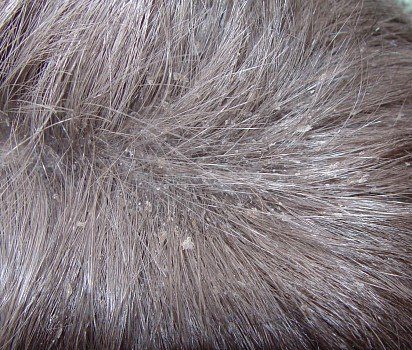
Photo of dandruff in a cat
Black dandruff is a sign of an infectious disease caused by parasites or a fungus. With such a symptom, the owner should immediately take the cat to a veterinarian.
If the increased separation of dead skin particles is localized near the tail, it can be assumed that the pet received a sunburn or contracted a fungal infection. The same location of seborrhea is observed in overweight felines (since it is physically difficult for the animal to reach this area).
Helminthiases, ringworm, joint diseases and other pathologies can lead to dandruff, localized not only in the tail region, but also in the lumbar region. And wandering dandruff (in the form of “paths”) on the back, muzzle, paws is often a sign of a subcutaneous tick.
How to treat dandruff in cats
Treatment of dandruff in cats is carried out in a complex and necessarily provides for compliance with hygiene rules. The owner of a fluffy pet will have to not only provide him with medicines, but also carry out a general cleaning of the premises, monitor his behavior so that there is no hypothermia, overheating, contact with foreign animals, and so on.
Therapeutic activities include:
- drug treatment of the underlying disease, if it has been identified;
- taking antihistamines that eliminate itching;
- taking vitamins;
- the use of medicinal detergents;
- folk methods;
- diet therapy (especially with overweight and allergic origin of dandruff);
- massage that improves blood circulation in the skin.
With increased dryness of the air, it is recommended to install a humidifier or use improvised methods.
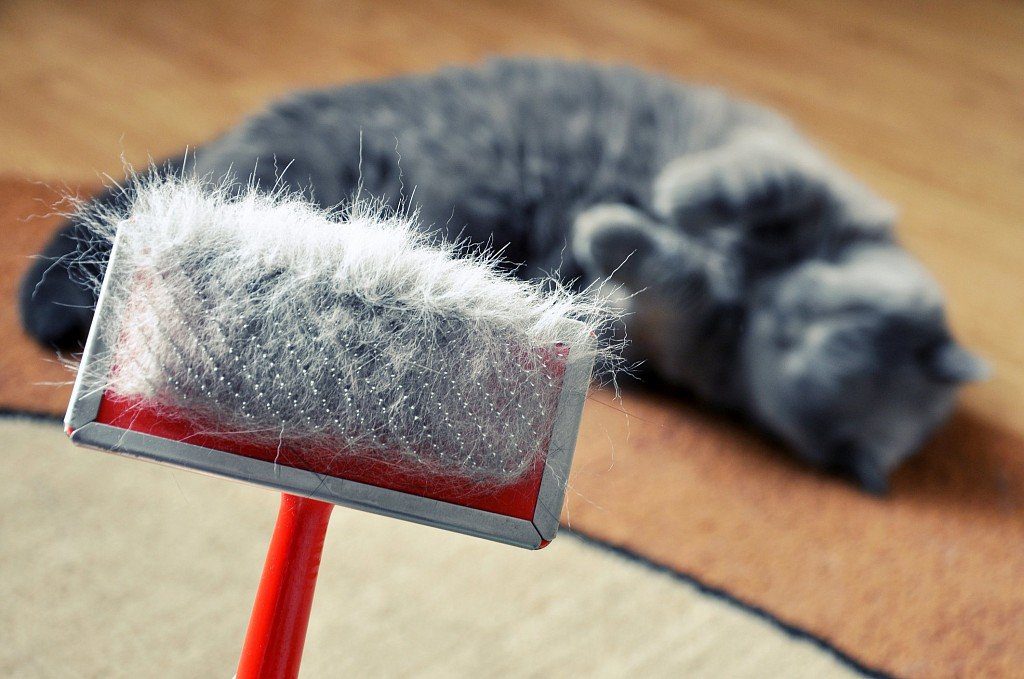
Periodic combing is one of the measures to prevent dandruff in a cat.
Medication
Drugs prescribed for the treatment of dandruff in mustachioed patients may belong to different groups. With inflammatory processes on the skin (dermatitis) or their high risk, the doctor will prescribe anti-inflammatory drugs, with itching – antihistamines. Depending on the disease that provoked seborrhea, it is possible to prescribe the following groups of drugs:
- anthelmintic;
- antifungal;
- hormonal;
- antibacterial.
If the reason lies not in an internal violation, but in an external factor, then, as a rule, they are limited to a diet, folk methods and a change in hygiene products.
Vitamins for dandruff
In the veterinary pharmacy today there is a huge selection of vitamin and mineral complexes that help restore the metabolism and appearance of the cat. Some of them are aimed at activating the growth of wool (Sherstevit), others have an anti-allergic effect (for example, Veda). There are complexes that normalize the work of the sebaceous glands, affecting metabolic processes in general (Farmavit-neo). Taking vitamins is a mandatory part of the treatment of dandruff, regardless of its cause.
Healing shampoos
Medicated shampoos will help rid your cat of severe dandruff. When choosing, you need to pay attention to the composition. They usually contain the following components.
Chlorhexidine
Antiseptic, antibacterial action.
Salicylic acid
Promotes faster rejection of dead skin particles. Has a healing effect.
Zinc
Has a healing effect. Stimulates the regeneration of the epidermis.
Burr oil
It has anti-inflammatory, regenerating, stimulating hair growth action. Softens the skin.
Plant extracts
They have a variety of therapeutic effects on hair and skin.
The most popular shampoos at the moment are: Fiprex (from external parasites), Doctor (anti-seborrheic, destroys the fungus), Biovax (normalizes the activity of the sebaceous glands).
Important: the therapeutic hygiene product must correspond to the type of dandruff in a cat. Otherwise, complications are possible.
Folk methods
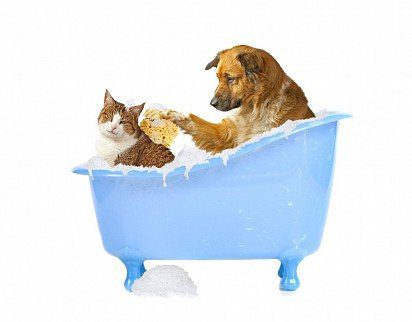
Medicated shampoos work well for dandruff
When choosing one or another folk method of treatment, you also need to consider what type of dandruff is formed in a cat. For example, when dandruff is dry, lactic acid, urea, and oils are used to wash the animal. If the scales are greasy, drying agents are used: salicylic acid, vinegar, preparations with sulfur. In any case, rubbing oils (burdock, olive, calendula) into the coat and skin gives a good effect, since in parallel the skin is massaged, blood flow improves, and the epidermis is cleansed.
Wool can be wiped with decoctions of medicinal plants. Often use infusions of calendula or succession, burdock, decoction of oats. Such rubbing can be done every other day. Dousing with herbal decoctions or bathing in them is allowed once every 1-2 months. You can combine washing with a medicated shampoo and rinsing the coat with a vegetable solution.
Why is dandruff dangerous for cats?
Running dandruff can lead to complications. One of them is hair loss, up to complete or local baldness. It happens that such places in the future are difficult or impossible to restore. Loss occurs due to the fact that accumulations of dandruff impede gas exchange in the skin, causing a violation of metabolic processes, weakening of the hair follicles.
Another complication is purulent inflammation of the skin, reaching the deep layers. The accumulation of dead epidermis serves as an excellent breeding ground for the reproduction of pathogenic microorganisms. Normally, they also live on healthy skin, but they cannot cause harm due to the good work of local immunity. With seborrhea, the immune system weakens, microbes multiply, redness, irritation, and itching occur. As a result of scratching, the infection penetrates even deeper – ulcers, pus, eczema appear.
Preventive measures
The appearance of dandruff on the cat’s coat can be prevented. This will require:
- comb your pet periodically, especially if it has long hair, as well as during molting;
- prevent the animal from being in the sun for a long time;
- provide a balanced diet, a sufficient amount of vitamins and minerals;
- when feeding with industrial formulations, carefully read the information about their ingredients, avoiding a large amount of allergenic substances (dyes, preservatives, flavorings);
- during water procedures, monitor the temperature of the water, preventing its increase;
- buy quality shampoos;
- regularly carry out the prevention of internal and external parasites;
- monitor the calorie content of the cat’s food, avoiding excess weight;
- eliminate stress.
When the first symptoms are detected, it is necessary to show the cat to the veterinarian. You should not treat dandruff on your own, through trial and error.



